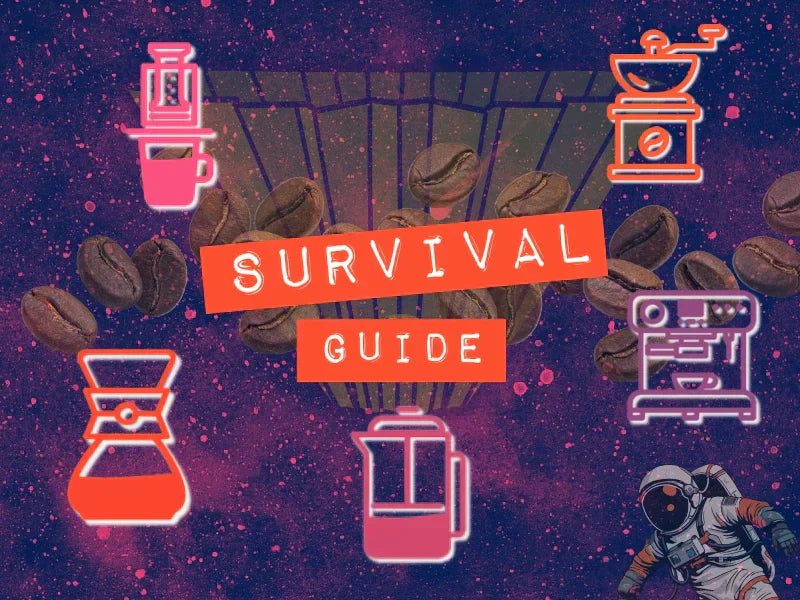Coffee Against All Odds: Your Brewing Survival Guide
Okay, fellow coffee adventurers! We all know that glorious feeling of the first sip of perfectly brewed coffee. But what happens when the universe (or just your kitchen) throws a wrench in the works? Power outage? Left the filters at home? Grinder finally gave up the ghost? Or maybe you're dreaming really big and pondering coffee in orbit?
Fear not! A dedicated coffee lover can be resourceful. Let's explore how to tackle these coffee conundrums.
Situation 1: The Power Outage Brew (No Electricity)
The lights go out, but the craving for caffeine doesn't. Here's how to cope:

1. Heating Water: This is your first hurdle.
- Gas Stove: If you have one, you're golden. Use your regular kettle.
- Camping Stove: A portable propane or butane stove is a lifesaver.
- Grill Side Burner: If you have an outdoor grill with a side burner, fire it up!
- Fireplace/Wood Stove: With care, you can heat water in a suitable pot (cast iron, metal camping kettle) over a fireplace or on a wood stove. Be extremely careful with open flames and ensure your cookware is appropriate.
- Campfire: The truly rustic method. Use a camping percolator or a pot suspended over the fire.
2. Grinding Beans: Assuming you have whole beans.
- Hand Grinder: The MVP of powerless coffee. If you don't have one, consider getting one for emergencies (or just for fun!).
(If you have NO grinder at all, see Situation 3 below)
3. Brewing Methods: Any manual method works!
- Pour-Over (Chemex, V60, etc.): Heat water manually, grind with a hand grinder, and brew as usual.
- AeroPress: Totally manual, easy to use, and forgiving.
- French Press: Grind beans, add hot water, steep, plunge. Classic.
- Moka Pot: Can be used on a gas stove or potentially even carefully on a grill or campfire (watch the handle!).
- Cowboy Coffee: The simplest. Add coarse grounds to boiling water in a pot, let it steep for a few minutes, take it off the heat, let grounds settle (a splash of cold water can help), and pour carefully.
Key Takeaway: A hand grinder and a way to heat water without electricity (like a camping stove) are your best friends in a power outage.
Situation 2: The Filter Fiasco (No Paper/Metal Filter)
You've got the coffee, the grinder, the heat... but you forgot or ran out of filters! Don't despair.

1. Methods That Don't Need Separate Filters:
- French Press: It has its own built-in metal filter/plunger.
- Moka Pot: Uses its own metal filter basket.
- Turkish Coffee: Brewed in an ibrik/cezve; the ultra-fine grounds settle at the bottom of the cup. You drink around them.
- Cowboy Coffee: As described above, relies on gravity to settle the grounds. Expect some sediment.
2. Improvised Filters (Use with Caution & Cleanliness!):
- Clean Cloth/Cheesecloth: A clean, tightly woven cotton cloth (like a handkerchief or piece of a t-shirt, rinsed very well) or cheesecloth can work in a pinch. Line your pour-over device or funnel. Expect slower draining and potentially some fabric taste. Ensure it's thoroughly cleaned first.
- The Desperation Sock Method: Okay, this is extreme, but possible. Use a brand new, thoroughly washed, natural fiber sock (like thin cotton). Seriously, it must be clean! Use it like a cloth filter. Again, expect potential taste issues. This is a last resort!
- Fine Mesh Sieve: If you happen to have a very fine kitchen sieve, you could try brewing in a pot and pouring through the sieve, but most coffee grounds will pass through unless it's exceptionally fine mesh.
Key Takeaway: Methods like French Press or Turkish Coffee inherently avoid the filter issue. Improvising requires serious attention to cleanliness and managing expectations about clarity.
Situation 3: The Grinder Goes Kaput (No Grinder)
Your trusty grinder is dead, or you brought whole beans camping without thinking. Time for some manual labor!
1. Breaking the Beans: The goal is to make big beans into smaller pieces. Consistency will be terrible, but it's better than nothing.

- Mortar and Pestle: If you have one, this is probably the most controlled 'no grinder' method. Work in small batches.
- The Bag Smash: Place beans in a sturdy plastic bag (like a Ziploc, maybe doubled). Lay it flat on a sturdy surface (cutting board, not your nice counter). Use a heavy, flat object like a rolling pin, wine bottle, meat tenderizer, or even the bottom of a heavy pan to crush the beans. Aim for consistency, but expect failure.
- Hammer Time: Similar to the bag smash, but use a hammer. Go easy, you want to crush, not pulverize the bag instantly. Again, use a protective surface. This will be messy and uneven.
- Chef's Knife: Use the flat side of a heavy chef's knife to crush beans placed on a cutting board (like crushing garlic). Alternatively, carefully try to chop them, but this is difficult and potentially dangerous.

2. Brewing with Uneven Grounds:
- Forgiving Methods: Because your 'grind' will be wildly inconsistent (dust and boulders), methods that are more forgiving work best.
- French Press: Handles coarser, uneven grounds relatively well.
- Cowboy Coffee / Pot Brewing: Steep the inconsistent grounds in hot water. The bigger chunks will under-extract, the dust will over-extract. It won't be perfect, but it will be coffee.
- Cold Brew: Steeping grounds in cold water for 12-24 hours is very forgiving of inconsistent grind sizes. If you have time, this might yield the best result.
Key Takeaway: Crushing beans without a grinder yields poor consistency. Use forgiving brew methods like French Press or Cold Brew. Prevention (bringing pre-ground or a hand grinder) is key!
Situation 4: Coffee in Zero Gravity (The Final Frontier)
Okay, maybe not a common problem, but a fun thought experiment! How do astronauts drink coffee?
-
The Reality:
-
Instant Coffee: The most common solution for decades. Just add hot water to a specially designed drink pouch.
-
Special Pouches: Liquids behave differently in space due to surface tension and lack of gravity. Astronauts drink from sealed pouches with straws that have clamps to prevent spills.
-
ISSpresso Machine: Yes, really! A specially designed espresso machine flew on the ISS, creating espresso shots that were consumed from the zero-G pouches. It tackled challenges like fluid dynamics, pressure, and heat management in microgravity.
-
Theoretical Brewing:
-
Containment is Everything: Any brewing would need to happen in a completely sealed system to prevent floating grounds and hot water droplets.
-
Separation: Gravity won't pull grounds down. You'd need a sealed system with a plunger (like a modified AeroPress or French Press) or perhaps even employ centrifugation to separate liquid from solids.
-
Heating: Heating water safely requires specialized equipment.
Key Takeaway: Coffee in space relies on highly specialized equipment focusing on containment and managing fluids in microgravity. For now, stick to the specialized pouches or dream of the ISSpresso.
So there you have it! Our coffees taste great, no matter how you brew them, even in space! Check out our brew guide to learn more about some of the brew methods mentioned in this blog. Whatever the challenge, with a little ingenuity (and maybe some desperation), a cup of coffee is often still within reach. Happy brewing, no matter the circumstances!

